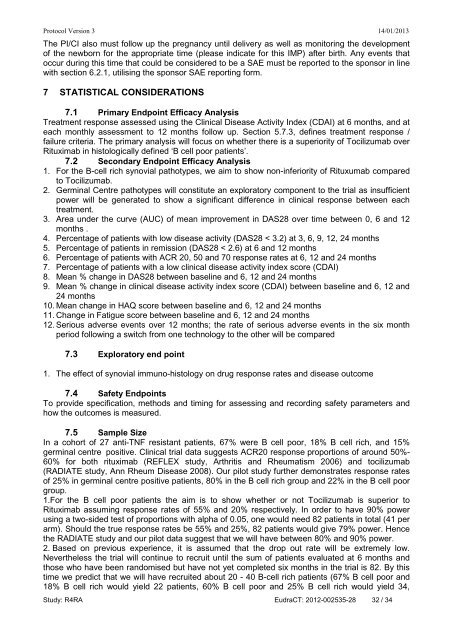Protocol Title : A Randomised, open labelled study in anti ... - EME
Protocol Title : A Randomised, open labelled study in anti ... - EME
Protocol Title : A Randomised, open labelled study in anti ... - EME
You also want an ePaper? Increase the reach of your titles
YUMPU automatically turns print PDFs into web optimized ePapers that Google loves.
<strong>Protocol</strong> Version 3 14/01/2013<br />
The PI/CI also must follow up the pregnancy until delivery as well as monitor<strong>in</strong>g the development<br />
of the newborn for the appropriate time (please <strong>in</strong>dicate for this IMP) after birth. Any events that<br />
occur dur<strong>in</strong>g this time that could be considered to be a SAE must be reported to the sponsor <strong>in</strong> l<strong>in</strong>e<br />
with section 6.2.1, utilis<strong>in</strong>g the sponsor SAE report<strong>in</strong>g form.<br />
7 STATISTICAL CONSIDERATIONS<br />
7.1 Primary Endpo<strong>in</strong>t Efficacy Analysis<br />
Treatment response assessed us<strong>in</strong>g the Cl<strong>in</strong>ical Disease Activity Index (CDAI) at 6 months, and at<br />
each monthly assessment to 12 months follow up. Section 5.7.3, def<strong>in</strong>es treatment response /<br />
failure criteria. The primary analysis will focus on whether there is a superiority of Tocilizumab over<br />
Rituximab <strong>in</strong> histologically def<strong>in</strong>ed ‘B cell poor patients’.<br />
7.2 Secondary Endpo<strong>in</strong>t Efficacy Analysis<br />
1. For the B-cell rich synovial pathotypes, we aim to show non-<strong>in</strong>feriority of Rituxumab compared<br />
to Tocilizumab.<br />
2. Germ<strong>in</strong>al Centre pathotypes will constitute an exploratory component to the trial as <strong>in</strong>sufficient<br />
power will be generated to show a significant difference <strong>in</strong> cl<strong>in</strong>ical response between each<br />
treatment.<br />
3. Area under the curve (AUC) of mean improvement <strong>in</strong> DAS28 over time between 0, 6 and 12<br />
months .<br />
4. Percentage of patients with low disease activity (DAS28 < 3.2) at 3, 6, 9, 12, 24 months<br />
5. Percentage of patients <strong>in</strong> remission (DAS28 < 2.6) at 6 and 12 months<br />
6. Percentage of patients with ACR 20, 50 and 70 response rates at 6, 12 and 24 months<br />
7. Percentage of patients with a low cl<strong>in</strong>ical disease activity <strong>in</strong>dex score (CDAI)<br />
8. Mean % change <strong>in</strong> DAS28 between basel<strong>in</strong>e and 6, 12 and 24 months<br />
9. Mean % change <strong>in</strong> cl<strong>in</strong>ical disease activity <strong>in</strong>dex score (CDAI) between basel<strong>in</strong>e and 6, 12 and<br />
24 months<br />
10. Mean change <strong>in</strong> HAQ score between basel<strong>in</strong>e and 6, 12 and 24 months<br />
11. Change <strong>in</strong> Fatigue score between basel<strong>in</strong>e and 6, 12 and 24 months<br />
12. Serious adverse events over 12 months; the rate of serious adverse events <strong>in</strong> the six month<br />
period follow<strong>in</strong>g a switch from one technology to the other will be compared<br />
7.3 Exploratory end po<strong>in</strong>t<br />
1. The effect of synovial immuno-histology on drug response rates and disease outcome<br />
7.4 Safety Endpo<strong>in</strong>ts<br />
To provide specification, methods and tim<strong>in</strong>g for assess<strong>in</strong>g and record<strong>in</strong>g safety parameters and<br />
how the outcomes is measured.<br />
7.5 Sample Size<br />
In a cohort of 27 <strong>anti</strong>-TNF resistant patients, 67% were B cell poor, 18% B cell rich, and 15%<br />
germ<strong>in</strong>al centre positive. Cl<strong>in</strong>ical trial data suggests ACR20 response proportions of around 50%-<br />
60% for both rituximab (REFLEX <strong>study</strong>, Arthritis and Rheumatism 2006) and tocilizumab<br />
(RADIATE <strong>study</strong>, Ann Rheum Disease 2008). Our pilot <strong>study</strong> further demonstrates response rates<br />
of 25% <strong>in</strong> germ<strong>in</strong>al centre positive patients, 80% <strong>in</strong> the B cell rich group and 22% <strong>in</strong> the B cell poor<br />
group.<br />
1.For the B cell poor patients the aim is to show whether or not Tocilizumab is superior to<br />
Rituximab assum<strong>in</strong>g response rates of 55% and 20% respectively. In order to have 90% power<br />
us<strong>in</strong>g a two-sided test of proportions with alpha of 0.05, one would need 82 patients <strong>in</strong> total (41 per<br />
arm). Should the true response rates be 55% and 25%, 82 patients would give 79% power. Hence<br />
the RADIATE <strong>study</strong> and our pilot data suggest that we will have between 80% and 90% power.<br />
2. Based on previous experience, it is assumed that the drop out rate will be extremely low.<br />
Nevertheless the trial will cont<strong>in</strong>ue to recruit until the sum of patients evaluated at 6 months and<br />
those who have been randomised but have not yet completed six months <strong>in</strong> the trial is 82. By this<br />
time we predict that we will have recruited about 20 - 40 B-cell rich patients (67% B cell poor and<br />
18% B cell rich would yield 22 patients, 60% B cell poor and 25% B cell rich would yield 34,<br />
Study: R4RA EudraCT: 2012-002535-28 32 / 34



